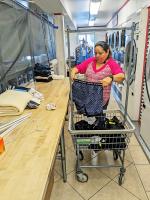GLENDALE, Ariz. — If you want to maximize your mat’s income, drop-off wash-dry-fold (WDF) service, pickup and delivery (PUD), and commercial work (smoke removal, restaurant linens, hair salon towels, etc.) are the popular income streams many owners use.
You can pull in thousands of pounds a week, but how do you manage your space and not interfere with your bread-and-butter self-service customers? How do you not compete with them for machines, folding tables and carts?
If your self-service volume is hopelessly slow after you’ve tried boosting it by installing new equipment, cleaning up your mat’s appearance, and securing adequate customer parking, you’re left with doing some kind of service work. The good part is that you don’t have many customers to bump carts with, so to speak.
Alternately, if your store is typically full of customers, doing service work there can be more daunting. When customers routinely see most of the machines occupied with other service work, they will go somewhere else. Your crew will have to wait to use some machines that are occupied by customers, but time is money. If they have work that must get out quickly, they will be forced to use the wrong machines for the job. So what can be done to lessen that impact?
In Part 1, I suggested my favorite solutions for performing other service work without interfering with your self-service business. Today, let’s talk about storage:
STORAGE ISSUES AND OPTIONS
Storage Alternatives — When on-site storage is an issue, what are the alternatives? Your basement? An off-site solution? Using an adjacent store’s extra space, such as its basement?
If an empty store space becomes available next to yours, consider grabbing it for storage, even if you don’t put any equipment in it. You could also use it as your primary service area with counter space and folding tables to service drop-off customers, and to store the laundry leaving your original mat. Just break through some openings between the two stores. It’s simple and cheap. Don’t forget to install cameras and mirrors.
The Joy of “Prepaids” — Customers who prepay tend to pick up much sooner. We gave a dollar off any drop-off order that was prepaid. It helped! And if the customer didn’t have the cash, we had an ATM right next to the counter. We posted signs at the counter asking to please pick up within five days, but the prepaids were more reliable than that with their timely pickups.
Contact the Slowpokes — Some people simply forget they have finished laundry to be picked up. We routinely called our customers with a friendly reminder about their laundry. Today, it could be an email or a text.
Raise Prices — Should your mat reach the point of bursting at the seams, with no way to expand, you could raise prices on both your self-service and drop-off work to make room. It would not be my first choice, but according to the law of supply and demand, whenever there is a shortage of goods or services, prices rise.
I was forced to do this quite a few times due to New York City retail space being so tight. I managed to expand two mats over the years, but it took a long time of waiting.
Keep in mind that all these tactics used for drop-off customers can also be used for pickup and delivery, and for writing up commercial work.
When we were doing smoke removal, we routinely received 600 to 1,000 pounds at a time but we arranged to have a week to get the work done. Eventually, I had to give this work up because it took up too much space. We stored it downstairs, which did help greatly, but carrying it up and down those stairs was a pain.
Coming up in Thursday’s finale: Smoothing out the peaks and valleys
Miss Part 1? You can read it HERE
Have a question or comment? E-mail our editor Bruce Beggs at [email protected].


































